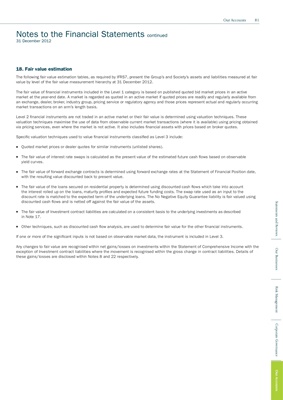
Our Accounts 81
Notes to the Financial Statements continued
31 December 2012
18. Fair value estimation
The following fair value estimation tables, as required by IFRS7, present the Group’s and Society’s assets and liabilities measured at fair
value by level of the fair value measurement hierarchy at 31 December 2012.
The fair value of financial instruments included in the Level 1 category is based on published quoted bid market prices in an active
market at the year-end date. A market is regarded as quoted in an active market if quoted prices are readily and regularly available from
an exchange, dealer, broker, industry group, pricing service or regulatory agency and those prices represent actual and regularly occurring
market transactions on an arm’s length basis.
Level 2 financial instruments are not traded in an active market or their fair value is determined using valuation techniques. These
valuation techniques maximise the use of data from observable current market transactions (where it is available) using pricing obtained
via pricing services, even where the market is not active. It also includes financial assets with prices based on broker quotes.
Specific valuation techniques used to value financial instruments classified as Level 3 include:
l Quoted market prices or dealer quotes for similar instruments (unlisted shares).
l The fair value of interest rate swaps is calculated as the present value of the estimated future cash flows based on observable
yield curves.
l The fair value of forward exchange contracts is determined using forward exchange rates at the Statement of Financial Position date,
with the resulting value discounted back to present value.
l The fair value of the loans secured on residential property is determined using discounted cash flows which take into account
the interest rolled up on the loans, maturity profiles and expected future funding costs. The swap rate used as an input to the
discount rate is matched to the expected term of the underlying loans. The No Negative Equity Guarantee liability is fair valued using
discounted cash flows and is netted off against the fair value of the assets.
Statements and Reviews
l The fair value of Investment contract liabilities are calculated on a consistent basis to the underlying investments as described
in Note 17.
l Other techniques, such as discounted cash flow analysis, are used to determine fair value for the other financial instruments.
If one or more of the significant inputs is not based on observable market data, the instrument is included in Level 3.
Any changes to fair value are recognised within net gains/losses on investments within the Statement of Comprehensive Income with the
Our Businesses
exception of Investment contract liabilities where the movement is recognised within the gross change in contract liabilities. Details of
these gains/losses are disclosed within Notes 8 and 22 respectively.
Risk Management
Corporate Governance
Our Accounts